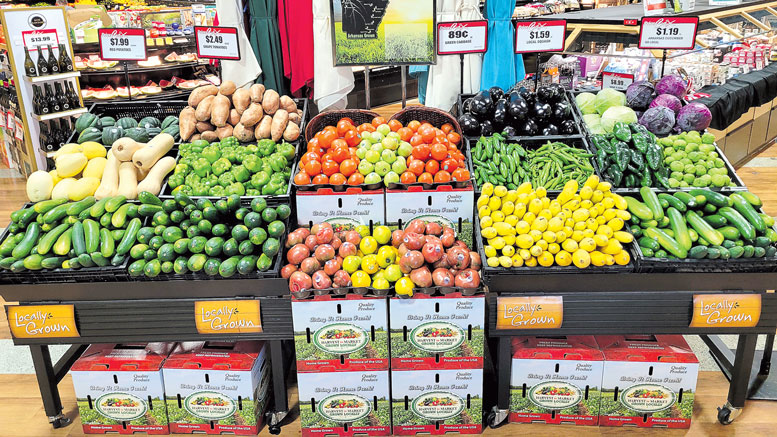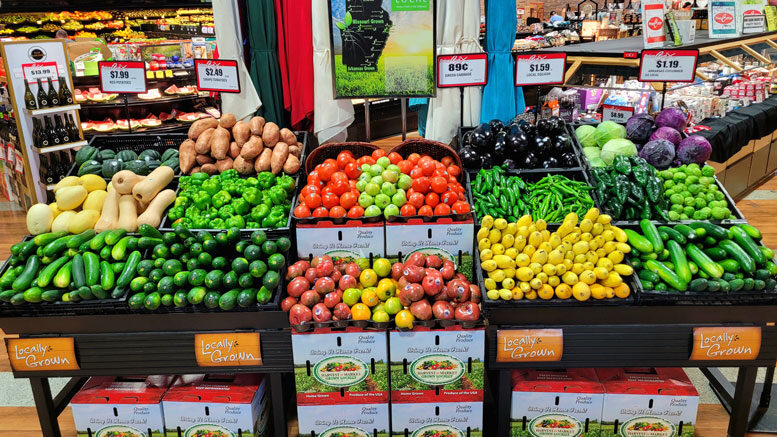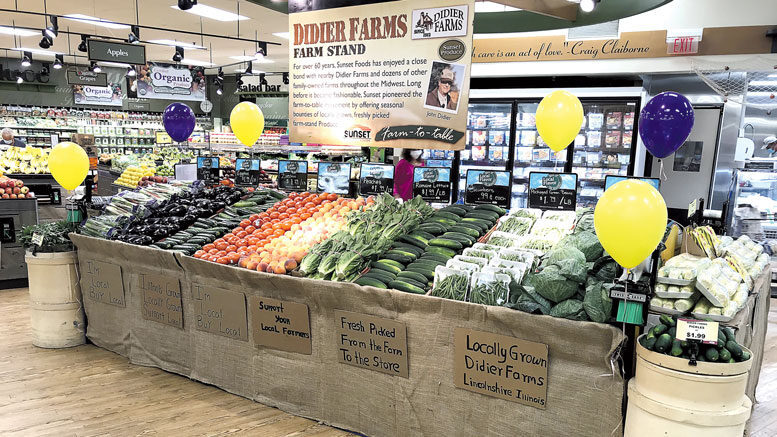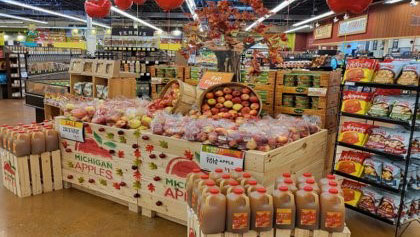Fresh Produce From the Midwest? Yes!
June 6, 2023 | 10 min to read
The Midwest showcases its strategic location as a critical hub for fresh produce, particularly during spring and summer harvests. Michigan leads in asparagus and apples, while retailers like Pyramid Foods and Sunset Foods emphasize local displays and promotions. With a robust farming ecosystem, the region supplies a diverse array of fruits and vegetables and meets consumer demand for locally sourced products. Innovative partnerships with local growers enhance the supply chain, improving freshness and availability year-round.

The Midwest’s strategic, center-of-the-country location is a two-way, buy-and-sell supply way.
Originally printed in the May 2023 issue of Produce Business.
The Midwest is famous for its meat and potatoes. But the region puts much more on Americans’ plates, especially in the spring, summer and early fall when local fresh fruits and vegetables harvest.
Consider that Michigan, one of a dozen states that make up the Midwest, produces more than 300 farmed commodities, ranking it the most agriculturally diverse state second to California, according to the Lansing, MI-based Michigan Department of Agriculture. As for fresh produce, Michigan leads all 50 states in asparagus production, producing some 20 million pounds annually, and the state ranks third in apple production, with a banner 1.5 billion pounds harvested in 2022.
This is only a taste of the volume and variety of fresh produce grown and shipped from the Midwest.
“Our markets are Missouri, Kansas, Arkansas and Oklahoma, and there are many seasonal items we take advantage of all year long. Spring and summer bring squash; cabbage; corn, okra; green beans; cucumbers; bell peppers; variety peppers; eggplant; assorted lettuces; potatoes; tomatoes; cantaloupe; watermelon; peaches; and berries,” says Mark Hendricks Sr., produce director at Pyramid Foods, a Rogersville, MO-headquartered 37-store retailer that includes Price Cutter, Save-A-Lot and Country Mart.

“Fall crops include pecans, apples and all the pumpkins and ornamentals you can imagine.”
Pyramid Foods’ supplier, the Springfield division of Associated Wholesale Grocers, is located nearby, Hendricks adds, which benefits its perishable operation “because of connections to area farmers for local product and to cut down on the time from harvest to shelf with quick turns out of the warehouse. It also carries products from all over the world, so the selection is never a problem, and the seasonal produce is always available as soon as the markets break.”
STRATEGIC LOCATION
The Midwest’s strategic, center-of-the-country location is a two-way, buy-and-sell supply way.
“The Midwest is an important hub for this country,” says Tim Fleming Jr., vice president of Strube Celery & Vegetable Co., a full-line wholesaler and receiver located on the Chicago International Produce Market.
“We have the advantage of pulling products from throughout the Midwest, basically everything from apples to zucchini. There’s still a large population that walks the market to see and pick out their produce, but more and more orders are by email or phone.”
“From the Midwest, there’s an ability to supply both the East and more western states with fresh produce. This allows produce to spend less time traveling from one coast to the other, which equates to a fresher product hitting the dinner table,” says Ryan Dietz, president of Heartland Produce Co., a broadline distributor based in Kenosha, WI.
PRODUCE BEYOND LOCAL SEASON
Given that the Midwest has a defined growing season, wholesalers supplement local programs with products grown in other areas nationally and internationally.
“We partner with a good produce wholesaler, explain grades, specs, grower labels and work it out category by category,” says Vince Mastromauro, director of produce operations at Sunset Foods, a five-store chain based in Highland Park, IL.

PHOTO COURTESY SUNSET FOODS
Mastromauro also works directly with local and regional growers, for a full year-round selection for his customers.
For Bob Hartmann, owner of Fresh Alliance, based in St. Louis, it’s nearly a straight shot to the Mexican border in McAllen, TX, to import tomatoes, sweet bell peppers, cucumbers and limes for Midwest retailers.
“The local product is big in the summer, but when that’s done, we make sure our customers — retailers, club stores and wholesalers — have good, high-quality supplies of these staple produce items,” says Hartmann, who packs under the Red Wagon Farms and Margaritaville brands.
“We pull from Nogales, too, but they finish up in May, and Texas crossings continue into June. We also follow the harvest up the coast starting with cukes out of Georgia, then the Carolinas, and finish up in Michigan.”
Similarly, given that Detroit sits right next to the Canadian border, tomatoes from Leamington, Ontario, greenhouses are an item sourced by Ben B. Schwartz & Sons Inc., a full-line wholesaler and receiver on the Detroit Produce Terminal.
“We also source from Mexico, and truck imports that come in from ports in Wilmington, DE, and Miami,” says Jordan Grainger, vice president of sales and business development. “We’re not tied to any one growing area; for us, it’s sourcing the best quality for our customers.”
TOP FRESH-MARKET CROPS
Local, or Midwest regional, is the name of the game this time of year.
Midwest consumers like to see products that are grown locally and have an expectation the product will taste better, will be fresher and will support local farmers, says Heartland Produce’s Dietz. “Having a vast amount of rural farmland, when paired with ideal growing conditions from spring until fall, makes the Midwest an important contributor to the country’s fresh produce supply.”
Local, or Midwest regional, is the name of the game this time of year.
The Midwest season starts with lettuces in the spring, says Scott Danner, general manager for C&C Produce, a North Kansas City, MO-based subsidiary of GS Foods Group Inc. in Ontario, CA, “and goes right through hard squashes in the fall.”
Michigan asparagus is an early, short-window crop that harvests anywhere from late April to early May and runs six to eight weeks into June, explains Trish Taylor, marketing manager for Riveridge Produce Marketing Inc., in Sparta, MI. “Most asparagus growers are apple growers, too. Asparagus provides good cash flow to start the season. Michigan is the only state that hand-snaps asparagus. One-pound bundles are most popular, but we also sell asparagus in 1- and 2-pound bags, and a 12-ounce microwavable bag.”
Variety is a key niche for Buurma Farms Inc., in Willard, OH, with farms in both Ohio and Michigan.
“We grow 30 different types of vegetables. Radishes, lettuces, turnip and mustard greens, and cilantro and dill start in May,” says Chadd Buurma, president. “By the Fourth of July, we have everything except sweet corn. That includes beets; green onions; parsley; kale; celery; green beans; cucumbers; zucchini; and cabbages. Napa cabbage and Bok choy are two newer items that are taking off. Once we start a commodity, we stay with it for a consistent five- to six-month supply, barring weather. This means a wholesaler or retailer can make one call to us, and we can put together a full load with 20 different commodities, thus making it convenient for the buyer.”
Corn is big in the Midwest, and nine-plus states make up the Corn Belt. This refers to field corn for animal feed or processing. However, sweet corn for the table grows here, too.
“Beginning in July, we start to see Illinois, and even Wisconsin sweet corn crops starting to make way into the supply chain,” says Heartland Produce’s Dietz.
Bi-color sweet corn is a big seller at Sunset Foods, says Mastromauro. So is an ultra-sweet variety called Mirai.
POTATOES IN THE HEARTLAND
Potatoes are an iconic Midwest crop, and new crop starts harvest in June and July, according to Michael Gatz, director of business development for Bushman’s Inc., in Rosholt, WI.
“Since the pandemic, demand is up for all varieties,” he adds. “What’s different is that 20 years ago, when I was a retailer for Roundy’s, 70% of the potatoes we stocked were from Idaho and 30% from Wisconsin. Today, retailers here carry 80% Wisconsin and 20% Idaho, and this is driven by the variety grown here, plus the ‘buy local’ appeal.”
There’s more interest in golden potatoes, and B’s are gaining in the marketplace, adds Cassie Krebs, administrative and marketing assistant and food safety coordinator for Gumz Farms, in Endeavor, WI. “Varieties are improving for quality and storage length. Also, we have invested in state-of-the-art, climate-controlled storage, so we can supply our potatoes and onions locally, longer through the year.”
SWEET SUPPLIES
On the fruit front, “We have a few varieties of peaches and apples from Missouri that are popular, and Kansas apples were a hit last year,” says Pyramid Foods’ Hendricks.
Blueberries are big from Michigan and so are apples.
Although it’s too early to predict the 2023 crop size, Michigan had a record-sized crop in 2022 and will have many varieties available through summer. “Near year-round availability of most varieties ensures a steady supply of fresh Michigan-grown apples to our customers,” says Diane Smith, executive director of the Michigan Apple Committee (MAC), in Lansing, MI.

However, harvest traditionally starts in late August with older varieties like Ginger Gold and Paula Red, says Riveridge’s Taylor. “Early season Honeycrisp starts in early to mid-September.”
Gala, Fuji and Honeycrisp apples are favorites grown in Michigan. EverCrisp is gaining popularity as a late-season variety that stores well and maintains great quality, Smith adds. Many newer managed varieties such as SweeTango and Smitten, among other emerging varieties, are also grown in Michigan.
Value-added produce opportunities are expanding out of the Midwest. A good example is C&C Produce’s Cool Creations line. The extensive line offers fresh-cut fruits and vegetables in convenient combinations and categories like grillers, veggies and grab-and-go. Examples of each are a Corn on the Cob Kabobs, with green and red pepper, red onion, zucchini and yellow squash and corn; Corned Beef Cabbage Kit with green cabbage, red potato, carrots and yellow onion; and cut fruit and vegetable trays.
“More and more retailers and foodservice operators want knives out of the backroom,” says Danner.
GO MIDWEST FOR PROMOTIONS
Local fruit and vegetable displays and promotions at retail are huge, and the Midwest is positioned to meet this supply and demand.
“We have heard from major retailers that local programs have become the most important marketing program for growth in the produce department,” says MAC’s Smith. “Our regional account managers work with buyers, category managers and in-house marketing departments to offer the most current digital, print and point-of-purchase marketing.”
Pyramid Foods features a local display beginning in May through August and displays the crops as they are harvested each week, says Hendricks. During those weeks, the main display at most stores are either out front on the porch or in the lobby as the customers come in the store. “We also dedicate several ads to only local products and call out the farmer where possible to give a customer a feel for where we are sourcing their food.”
Similarly, says Sunset Foods Mastromauro, “for every local item on display, we sign it by region, or Midwest, then state, and then the farm or farmer name. We’ll use social media to let customers know what’s available that day or week, and locally sourced fruits and vegetables will take a bigger presence in our ads.”
Suppliers are essential cogs in the local deal wheel.
“Over the years, we have built strong relationships with retailers across the Midwest as well as strong relationships with our local growers. We can work with our growers to offer our retailers promotable products throughout the local season. When products are at a promotable value, retailers then market these items to drive sales,” says Heartland Produce’s Dietz.
Looking ahead, “there are good opportunities for future growth of Midwest grown produce. Retailers are always looking to promote new locally grown items,” he says.
12 of 14 article in Produce Business June 2023

